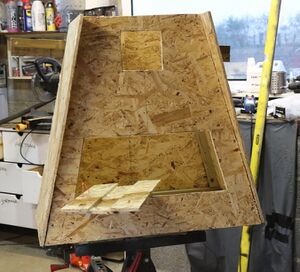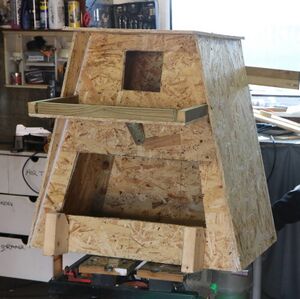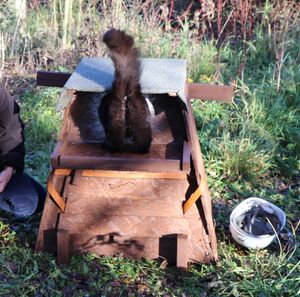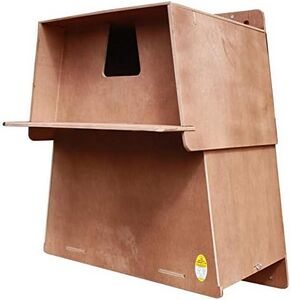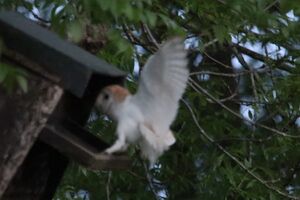
Our Location
We are located at the very edge of a rural village (Upwell in Norfolk, UK).
We moved here five years ago, from London and quickly realised that wildlife was going to become a massive part of our lives.
Our back garden is right next to some wasteland, a copse of tall ash trees and miles upon miles of open agricultural fields which are lined by dykes and ditches, habitat for much of the owls prey. We are very fortunate!
Why's this on a Cooking site?
Cookipedia is my personal 'hobby' and it runs on a server using the MediaWiki software platform, as does Wikipedia so is an ideal way to publish any form of information. I use Cookipedia to publish anything that I think might be useful to others. This article has nothing to do with cooking though, that I can assure you; although I am informed that owls favourite party food is Mush’Shrew’ms, ‘Vole’avaunts and Micecream! (stolen from another owl site). Thanks Alison!

Building a Barn Owl Nesting Box
There are many plans available on the Internet and if you are reasonable with DIY projects, you should find this fairly simple - getting the box up the tree and fitted will be the challenge!
We have built two Barn Owl Boxes, one based on the plan found on the Barn Owl Trust website; you can download the hi-resolution plan here, the second Barn Owl Box was based on a simpler generic plan, which does not include the essential landing and exercise platform, download the hi-resolution plan here.
Construction materials
Cost obviously a concern nowadays, so unless you can afford 18mm marine ply, which is the ideal wood, but expensive, I would go for Oriented Strand Board (OSB). It's easy to work with and is reasonably water resistant and rot proof.
Screw and glue all panels. Use an acrylic sealant inside the box to seal any poorly fitting joins. Treat the outsides only with a wood treatment such as fence paint. Cover the roof with roofing felt, or if cost is important, a few layers of thick plastic sheeting such as Damp Proof Membrane. Check there are no screws protruding inside of the box.
Do not rely on screws alone to secure mounting bars and external fixings; that's how our original box is so badly tilted, the plank used to level the box was screwed into the base of the box and did not hold up to strong winds. Use coach bolts combined with large washers to ensure any mounting points stay on the owl box forever.
Once your box has been mounted in its tree any changes or modifications, such as adding cameras inside the owl box are likely to be very difficult to make because access can be very challenging. Also, as with our box, it appears to have been constantly occupied!
Drainage and ventilation
You can guarantee that water will get into the box, however well you make it. Our first box even had a large egg-shaped hole in the back panel thanks to our local woodpeckers, so ensure you drill some 15mm holes in the base to enable water to drain out.
I would also suggest some ventilation holes in the sides of the box too. In May last year we had two adult owls and two young fledgling in the box at the same time. It's going to get quite fetid in there if there is not adequate air circulation!
A benefit of our accidental tilt, see pictures below is that it enables the owls to grip the inside of the box and stand and look out of the entry hole. Our camera system shows they do this for hours on end, day and night. It wouldn't take much to modify your box to do this; a few slats inside the box under the entry hole, or maybe even a layer of chicken wire would be enough. The benefits are enormous; both for the owls looking out and for us to be able to see the box is occupied, even from a distance.
Considered wisdom is to have a removable panel to allow for cleaning; however for many reasons I would not worry with this. Firstly our box has been occupied continually from the time we first discovered that owls were nesting in our box. Access to the box is exceedingly difficult as it's above a 30 year old bramble patch and a small dyke and due to the movement of the box, I would not be happy resting a ladder against it, even though this was built into the design. I'm also not the least bit comfortable 6 metres up a ladder trying to unscrew panels on the front of the box. If you think you will be cleaning out your box, I would position a hatch on the side of the box, then you can just rest your ladder on the tree and not have to get to the front of the box.
-
Plan for building a barn owl tree nesting box
click image to access larger hi-res versions -
Mark the panels out directly onto your OSB sheet
-
Cut the panels out with a jig-saw or circular saw
-
Almost finished, showing the cleaning panel
-
The completed owlbox ready for treating
-
Being checked by our buildings inspector 😸
-
You won't always get what you wish for. Squirrels and wasps were all we ever got in out Little Owl box
-
A much simpler owl box that is very easy to build
You will need to add an exercise / landing platform for the young
Positioning your Owl Box
Trees overlooking fields are ideal locations for barn owl boxes and from our experience a copse seems to be perfect. With our night vison camera we regularly see an owl fly to a nearby tree, sit there for an hour, then move to another tree for 30 minutes, before eventually settling on the box, and then another 15 minutes on and around the box before eventually entering the box. A lone tree or post would not enable them to exhibit this behaviour.
Avoid placing a barn owl box near to powerlines.
You owl box needs to be at least 6 metres above ground on a post or open tree. The entrance hole should face north and not obscured by branches or leaves. We've found it useful that the east side of the box is not in shadow as this allows the early morning sun to warm the box. Ideally the box should be level, even though the owls seem to have been perfectly happy in our wonky box!
Mounting your owl box
Fitting your owl box up a tree or post is going to be a two person job. Your completed barn owl box will be far too heavy to carry up a ladder and extremely awkward to manoeuvre, especially 6 metres up a ladder. We found the easiest way to get the box up the tree was to use a block and tackle system (£8.95 Amazon UK - 2023) - this makes lifting the box into the tree a trivial job. Rather then screwing or bolting the box to the tree, the second time we fitted a box we just used two ratchet straps (£8.25 for 2 Amazon UK - 2023) to hold the box to the tree. They will never rot or rust and can easily hold the required weight. You might want to paint them first or find a duller colour; orange is a bit gaudy!
-
A pulley system makes fitting you owl box easier (£8.95 Amazon UK - 2023)
-
Ratchet straps are ideal for permanently securing your owl box to the tree (£8.25 for 2 Amazon UK - 2023)
Owls are territorial, but...
As with most birds of prey, barn owls are territorial so nesting boxes should be placed at least 200 metres apart; with the following exception...
Last year we took part in an evening nature walk with Nigel, a local gamekeeper from Church Farms, Stow Bardolph. He has 50 years experience so knows a few things about barn owls.
After Nigel told us how owls are strongly territorial, we mentioned that we had put a second owl box up in the same copse, only 15 metres away from the original box and thought we would need to remove it. He said that we had inadvertently done our nesting parents a favour by adding a second box. The parents will have somewhere to escape to when the young fledglings start becoming noisy and boisterous! Since learning this, we've often seen the parents visiting the second owl box!
Even so, we eventually had to remove the second box because its position in the trees meant we could not protect it from cats in the same manner we had with the first box. The way the trees were so close together meant that a cat could easily jump from one tree to another to access the box.
How we discovered we had barn owls!
Our barn owl box had been mounted where it is now for four years and in that time we had never seen any activity leading us to believe that it was occupied.
About a year ago (February 2022) we decided to clear a way into the bramble patch, get a set of ladders up into the owl box tree and do something about the massive tilt that occurred when part of the structure we used to mount the box had fallen off. After 40 minutes work with the brush-trimmer working our way up to and underneath the tree I managed to get the ladders under the owl box. Imagine our surprise when I accidently knocked the box with the ladder and two barn owls flew out and into a nearby tree! We decided to leave the owl box in its tilted position as its occupants were obviously happy with it as it was.
We now firmly believe that owls had probably been in that box for many years, we had just never seen them. We now know to watch them properly you need a camera mounted close to the box that has night-vision capabilities.
Other birds on the owl box
If you see other birds on or around the owl box, don't be fooled into thinking the box is unoccupied by owls. We often see pigeons on and around the box during the day when we know from video evidence that the owls are inside. They don't seem to be bothered by this, though I expect it might differ if they had young and the birds were magpies.
Protecting the Owl Box from Predators
-
Why our owl box needed protection 🙁
-
The shuttering protects the owl box from cats and is also used as a landing stage by the barn owl
-
A close-up of the barn owl box predator protection
The day after we fitted the new box to the tree, we discover one of our cats sitting right on top of the owl box. This was something we needed to address urgently. The tree the box is in is at the edge of the copse and no other trees are near enough to allow predators to jump from tree to tree so we mounted shuttering halfway between the ground and the owl box so although predator could climb the tree they could not get past the shuttering. While owls may be prey to buzzards and hawks and maybe foxes, I think in the United Kingdom cats are the only threat to owls once they are safely in the box. Just be aware of this threat when choosing a spot for your barn owl box.
A Ready-made Owl Box
Sadly, after six years our original owl box rotted and dropped out of the tree. Using the owl box camera I could see that it was occupied when it fell out of the tree. Luckily it fell onto a huge thicket of brambles which broke its fall and enabled the owl to escape the box!
I checked the box first thing the next morning and it was empty, no owls and no sign of nesting activity - phew!
Now, the first priority was to get another owl box back up the tree quickly, otherwise we might not get the owls back. Building another box from scratch was not possible due to the timescale so I looked for a good quality ready-made owl box. In the end I settled for the flat-packed Secrets Barn Owl Nest Box from Amazon UK - £157.00 March 2024
I'm glad I chose this owl box. It turned up in a few days and was simple to assemble. Based on what we had seen from the camera I made a small modification to the box. I enlarged the platform to almost double the size to make plenty of room for both owls at the same time. I also added a 2cm x 2cm strip along the leading edge as this seemed to make it easier for them to grip when landing. A cross-member was bolted to the back of the box so it could hang between two branches and a bottom strut bolted to the base to hold the box away from the tree at the angle the owls had been used to!.
The very next evening, the pair of barn owls were back in the box. 💜
-
Back in the new owl box as if nothing had changed!
Watching the Barn Owls
Not a portable wildlife camera
I've not had great deal of success with the portable wildlife cameras currently available, they need to be really close to the owl box to record reasonable pictures especially at night, on most of the portable wildlife cameras that I'm aware of the batteries need to be changed regularly and to replay recordings, the memory card needs to be taken out of the camera. This means getting really close to the owl box and the owls, which I am very reluctant to do. Another problem is that the recordings are triggered by motion detection, in a tree lined copse, especially when in leaf, the camera is likely to be triggered constantly. I don't wish to put you off trying, but I would recommend you borrow one first to see if it's going to give you the results you expect.
A hard-wired video camera
We have an IP security camera system which uses cheap CAT5 network cable to connect the cameras. This powers the camera and carries the video and sound back to the recorder. It should easily be able to run at distances of 100 metres (300 feet). The security camera system records constantly and recordings can be accessed by a networked PC or even a mobile phone. It's not a trivial system to setup but it does give fabulous results - we can even sit indoors of an evening and watch the owls on TV. Much better than watching TV.
You could also use a hard-wired security system like this to record owls actually in the box with the young. Just make sure you install it before you mount the box in the tree and it becomes occupied!
Why Wise Old Owl?
This is only my personal view but apart from actually looking intelligent, when watching the owls behaviour on camera we've often seen them sitting on a branch for more than two hours before moving back to the box or off out hunting. This puts you in mind of them sitting and thinking! Where we see them exhibit this behaviour it's probably not because they are hunting as they are over a massive bramble patch which would prevent them landing or attacking prey.
Barn Owl Synchronised Pair Video
Our nesting pair doing a bit of synchronised flying - unfortunately there's no sound on this vidoe as exprecince has shown they probably screech during this flying encounter.
Barn Owl on our washing line!
'Noddy', landing on our washing line! recorded from another camera.
Evidence that you have Barn Owls
When we did our evening nature walk with Nigel, a local gamekeeper from Church Farms, Stow Bardolph, he showed us underneath where barn owls had been perching. Their scat or faeces is very white, almost chalky due to the high protean carnivorous diet. There's very little evidence of solid matter though, almost all from liquid it seems. Different owls seem to use different perches, but very often the same perches, which increases the chance of seeing their scat. Look around the ground under trees near you owl box for evidence of this - it's pretty obvious once you spot it. It was even seen under where the owl sat on our washing line.
-
A barn owl has been sitting above here!
-
The two fledglings a few months after hatching
Great tit sees off the Barn Owl!
This morning at 5 am we happened to watch one of our nesting pair of Barn Owls fly across our field and land on an occupied Great Tit nest box we mounted on a telegraph pole. The great tit returned while the Barn Owl was still sitting on the roof of the tit nest box. To our amazement, The Great Tit constantly flew around the stationary owl; probably vocalising although we could not hear as we we re indoors. After a few minutes of this the Barn Owl flew across the field and out of sight, with the Great Tit appearing to chase the Barn Owl off!
Sounds highly improbably, but I can assure you it really happened. No photographs to prove this I'm afraid.
Progress of the Young Owlet Fledglings
Our video camera system enables us to view the owls easily, even at night. We were able to see immediately the young owlets started to exercise on the landing platform, and eventually when they fledged. Sadly, only one of the pair eventually survived; the survivor we called Noddy because of its peculiar habit of head-bobbing. It's a known behaviour pattern of many owls, owls cannot move their eyes as we can as an owl's eyes are fixed in position. The head movement makes up for this limitation. However, we had never seen this behaviour from the parents and it's very obvious, even on the darkest night at a good distance as the infra-red camera shows their eyes as lights, bobbing and nodding. It's enabled us to distinguish Noddy from the parents (unless the parents have started nodding too!)
Following our evening nature walk with Nigel where he showed us how to call a barn owl by making a kissing sound into a cupped hand. Apparently it sounds like wounded pry? I tried it once we got home - amazingly after a few tries, one of the owls popped its head out of the pop-hole! I was absolutely amazed - unfortunately it has only work a few times since then. I guess they've learned the difference between a wounded mouse and a fat bloke - quick learners!
-
The bashful owlet!
Barn Owl Yoga
Noddy, the bashful fledgling above, now has young of his/her own and loves a stretch exercise every evening before going out to hunt!
Key Facts about Barn Owls (Tyto alba)
- What they eat
- Mice, voles, shrews and some larger mammals and small birds
- Size
- Length: 33-39cm
- Wingspan: 80-95cm
- Weight: 250-350g
- Population
- UK breeding: 4,000-14,000 pairs
- Europe: 110-220,000 pairs
What a Barn Owl Sounds Like
The audio clip below is one owl in the box squawking and another owl flying up to the box and then circling, screeching. The clonk is the first owl landing on the perch on the box.
Barn Owl Breeding Facts
- Nesting period
- March to August
- Nest material
- Owl pellets (poo)
- Nest site
- Natural and man-made cavities, such as trees, cliffs, barns, buildings and nest boxes
- Number of eggs
- 4 to 6
- Number of broods (sets of young bird siblings, hatched at the same time by the same parents
- 2
- Incubation period
- 29 – 34 days - female sits on the eggs
- Fledgling period
- 50 - 55 days after hatching
#owlscreech #owlbox #owlnestbox #barnowlbox #owls #owl #barnowls



